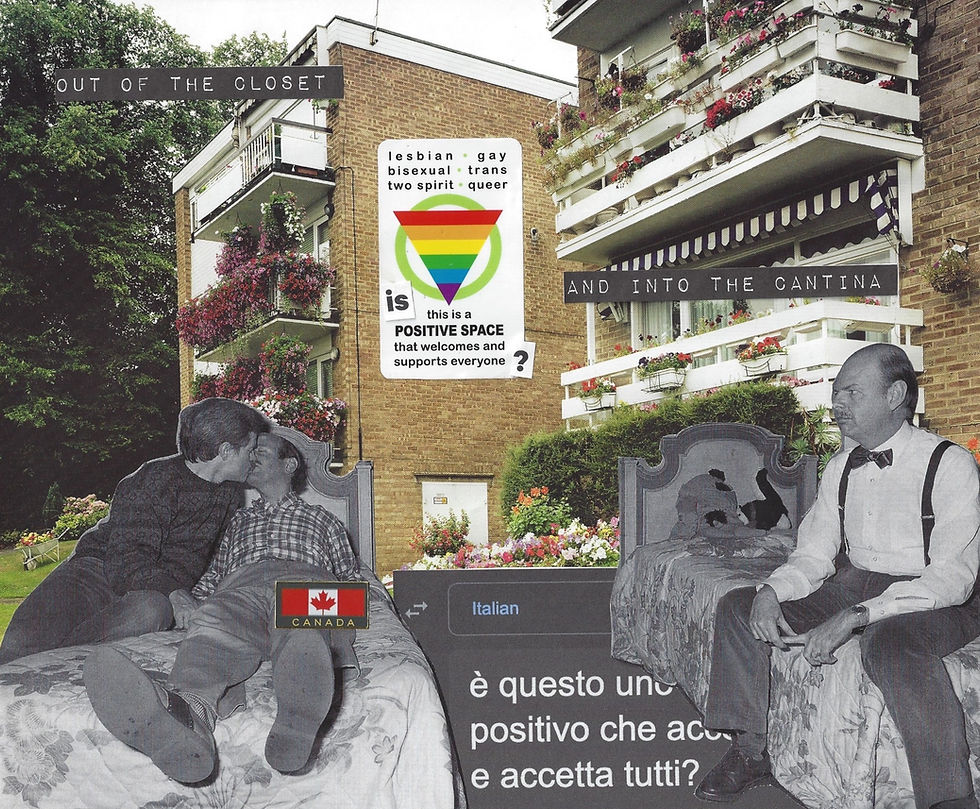Artist Statement: Out of the Closet and Into the Cantina
- Ariana Magliocco

- Dec 5, 2023
- 3 min read
Updated: Dec 14, 2023
Inspired by their involvement in the “Queer Italian-Canadian Artists” project, Ariana Magliocco (she/they) utilizes collage and multi-media visual prose to explore questions of queerness, community and cultural acceptance. Below, Ariana reflects on her collage “Out of the Closet and Into the Cantina.”

“Non sei né il primo né l'ultimo” - was what my Sicilian nonna said to me when I came out to her as bisexual. You're not the first or the last.
Working as a Research Assistant turned Project Manager on the “Queer Italian-Canadian Artists” project has been a profound and meaningful exercise in re-remembering that wisdom.
We are not the first or the last to be Queer and Italian-Canadian. We are not the first to struggle for acceptance over Sunday night dinner. We are not the first to feel the friction between our cultural and queer identities. We are not the first to feel isolated, abnormal or trapped in a familial and cultural environment that refuses to understand, adapt and acknowledge.
In interviewing over a dozen queer Italian-Canadians for this project, I've learned that despite the diversity of our experiences, commonalities emerge time and time again because of this shared cultural experience.
Many of us have fought to come out of one closet – to claim our place in the queer community - only to find ourselves in another culturally enforced closet, what I am likening here to the cantina.
In the basement of every Italian-Canadian I knew growing up, the cantina was a place of pride and cultural specificity. Quite literally cemented into the identity of Italians in Canada, this tiny cold cellar preserved tradition as much as it did food. Stepping into the cantina was like traversing across national borders of space and time. And as with most border crossings, this came with rigid declarations of who you are, and more importantly, who you are not.
While many of us are out to our friends, online or at work, we know not to wear our binders to visit the nonni or bring our partners to Pasqua lunch. Gendered roles and their accompanying romantic expectations were defined for us since we were kids. What it means to be a good Italian woman, or a good Italian man, has always required heterosexuality and an allegiance to patriarchal gender norms.
And yet -
In working on this project, I have seen ways in which cultural scripts have been challenged, re-claimed, and re-written. I’ve cried at stories of mothers and fathers embracing their queer children with open arms. I’ve listened as people have described the ways in which their nonna’s tough disposition or nonno’s quiet softness has informed their own gender non-conformity. I’ve watched as first, second, and third-generation Italian-Canadians have honoured tradition by refusing to let it die – by respecting it enough to let it grow and change and evolve.
We’ve never been the first, but we can be the last. The last to feel the stifling suffocation of being shoved into the cantina. Left in the dark. Forgotten in the back corner, behind the sugo and salumi.
This project has cultivated in me, a deep reverence for the queer ancestors and paesan who have left an inheritance of resistance in the face of oppression and joy in the face of exclusion.
And so, I ask our community:
What if the cantina wasn’t just another place of enforced hiding? What if the cantina was a place to preserve and protect what we cherish most?






Comments